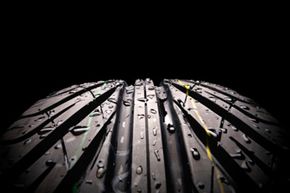\”

Your car\’s tires are where, literally, the rubber meets the road. But a lot of people take their tires for granted without realizing those flexible, vulcanized doughnuts are at the very front of a car\’s safety. But what makes a tire safe?
Tires serve a critical function on a car beyond taking a nice shine. From a broad perspective, tires:
- Cushion the car providing a more comfortable ride
- Support the entire vehicle weight
- Develop traction for driving and steering under a wide variety of road conditions
- Help absorb the massive forces even a small car generates during acceleration, braking, and cornering, allowing for a more stable ride
To perform those functions thousands of hours of engineering and hundreds of different components go into the design of a safe and effective tire. For example, an airplane tire may be the same size as a heavy hauler tire, but they\’re not even remotely the same in use, engineering or construction.
Yet there are similarities between all tires and knowing these similarities can go a long way towards choosing a safe tire for your car and your application.
Drivers should be concerned with four major parts of tire construction:
Sidewalls: Tire sidewalls help absorb shocks and impacts from road irregularities. They also serve as a structural element for the cord plies, adding overall strength. The rubber often contains antioxidants. These are released over the life of the tire and keep the sidewall supple as well as inhibit damage from ultraviolet light. The sidewall also contains all the necessary tire information including maximum pressure, speed rating and size.
Cord plies: These are nylon, polyester or rayon fibers serving as the foundation of the tire. The fibers are embedded in the rubber and provide the structure needed by the tire to carry a load. Passenger cars usually have two plies, while a truck tire could have as many as six to eight. Plies are laid out in specific designs based on the tires proposed use, but most drivers will see the stable radial-ply design.
Tire belts: Usually steel (hence the "steel-belted radial" heard so often in tire ads), these belts add strength and structural integrity to a tire. Specifically, they restrict ply movement and keep the tire from deforming as it deals with the physical forces inflicted by the car\’s movement.
Tire tread: This can be one of most complex elements of the tire. Treads are made of several different types of rubber balancing out wear resistance with grip, enough flexibility to shed water without deforming the tire, but it must give enough to roll over smaller obstructions without transmitting that feeling to the driver. It must also fit the driving conditions — a race car driver wouldn\’t use a daily-driver tire, and a commuter wouldn\’t use racing slicks.
As long as the four elements above are blended correctly, a tire will be safe. As to what is considered safe for a given tire, the answer is to not stray too far from the tires that came with the car, or the specific tires a car manufacturer recommends for a given vehicle.
One last point to mention, remember to frequently check the air pressure in your tires. The correct pressure listed in the owner\’s manual or on the car\’s safety placard by the driver-side door B-pillar, allows the tire to function as it\’s designed. Too much air, or too little, messes with the complex engineering in the tire and can lead to early tire wear or even a blow out. Also keep an eye on tire wear, for cuts or gouges in the sidewall, or anything that can compromise the strength or structural integrity of the tire.
For more information about tires and other related topics, follow the links on the next page.
Lots More Information
Related Articles
- 5 Things to Look For in a New Tire
- 5 Warning Signs You Need New Tires
- Car Smarts: Tires
- How Tires Work
- How Q Tires Work
- How Self-inflating Tires Work
- How Self-regenerating Tire Tread Works
- How Tire Traction Works
- How the Tweel Airless Tire Works
- What is an eLSD?
- Are some tires safer than others?
Sources
- Knowles, Don. "Automotive Suspension & Steering Systems." Thomson Delmar Learning. 2007.
- TireSafety.com. (Aug. 10, 2010) http://www.tiresafety.com












